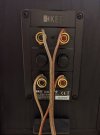Hi,
I’m thinking of buying a pair of Bi-Wiring speaker cables with 2 connectors on one side and 4 connectors on the other side. Are there special considerations in comparison with conventional speaker cables? Do expensive cables provide more advanced sound quality?
I’m thinking of buying a pair of Bi-Wiring speaker cables with 2 connectors on one side and 4 connectors on the other side. Are there special considerations in comparison with conventional speaker cables? Do expensive cables provide more advanced sound quality?

